Most of us cringe—or panic—when something catches our dog’s eye and he takes off in pursuit. But for dogs in the sport of lure coursing, the chase is exactly what they and their owners want.
Lure coursing is a simulated hunt for dogs. It was designed for sighthounds—dogs that hunt by sight, not scent. While many dogs will chase anything that moves, sighthounds are typically the fastest and most agile.
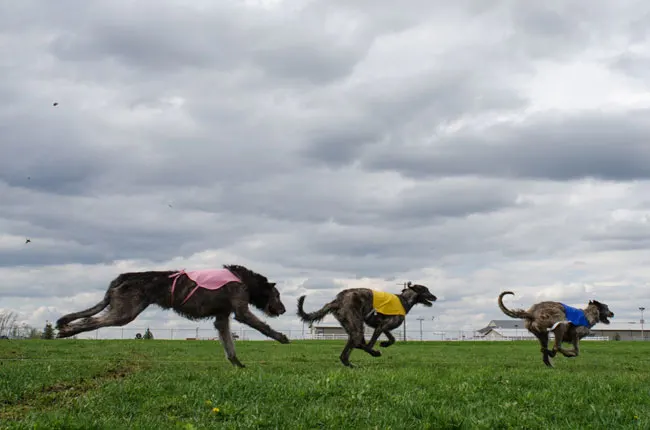
This post is part of our series on organized dog sports. Check out the other sports we’ve covered:
- Disc dogs
- Dog dock diving
- Flyball
- Rally obedience
- Skijoring with your dog
- Training sled dogs
- Bird hunting
- Off-leash hiking
- Running with dogs
- Biking with dogs
What is Lure Coursing?
Lure coursing takes place on large open field. A lure (which looks like a white plastic bag) is tied at the end of a string and pulled over the ground along a mechanical pulley system. The lure travels across and around the field while the dogs—three at a time—chase it.
As soon as the lure starts, the dogs are running flat out as fast as they can go. The lure will turn as it travels across the field, and the dogs have to show exceptional agility to turn at top speed.
Best dog breeds for lure coursing
Lure coursing events are specifically for 13 breeds of sighthounds named by the American Kennel Club (AKC) and the Canadian Kennel Club (CKC). The breeds include:
- afghan
- azawakh
- basenji
- borzoi
- Scottish deerhounds
- greyhound
- ibizan
- Irish wolfhounds
- Italian greyhound
- pharaoh hound
- Rhodesian ridgeback
- saluki
- and whippet
Other breeds or crossbreeds of dogs are allowed to participate in other events such as the Chase Ability Program and the Sprinter Program.The AKC’s FastCAT event is also open to all breeds and mixed breeds (more info below).
Lisa Miceli’s choice of dog—the borzoi—led her to lure coursing. She first saw a borzoi when she was about 12 years old.
“Somehow looking at the borzoi I kind of knew that they would be spectacular to watch while they were running full out,” she says.
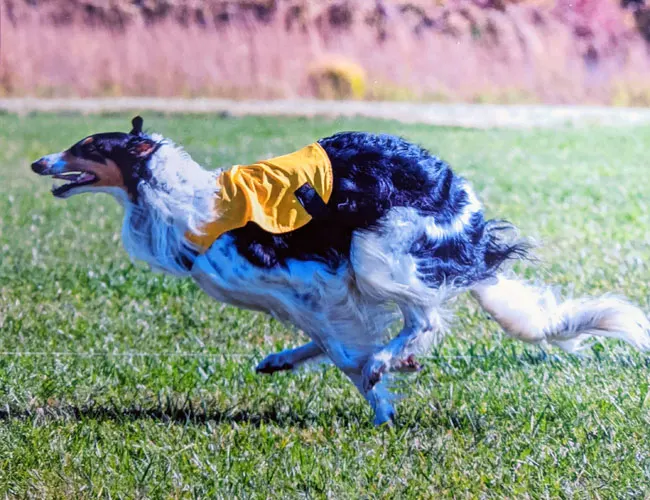
She finally got her first dog, a borzoi of course, when she was 30 years old. And at her breeder’s suggestion, she checked out lure coursing. Now, after three decades in the sport, she says, “To watch them running, 30 years later, it still takes my breath away.”
Lure coursing events
Many organizations offer trials, practices and competitions in lure coursing through the AKC or CKC.
Three dogs run at a time, and each trio is composed of the same breed. The dogs run the course twice and receive points in five categories (see more below). The points from the two runs are added together and the winners of each breed then have the option of competing for Best In Field.
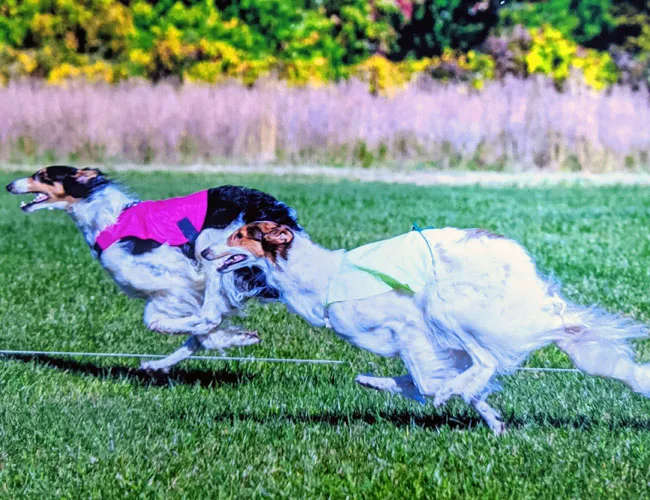
Miceli serves as a CKC judge.
What the judge evaluates:
As a judge, she’s evaluating dogs for their enthusiasm, speed, agility, follow and endurance.
- Enthusiasm (15 points under CKC rules): “You want to see that the dog is excited about what they’re going to do and they’ll show you that on the starting line and they’ll show you throughout the course. A dog may get caught a little bit behind but then it will throw on a burst of speed to try and get caught up, and that really shows you enthusiasm.”
- Speed (25 points): “They’re not just out there running around the field doing their thing. You can see them competing with one another.”
- Agility (25 points): “These dogs can go out at full speed and literally turn on a dime.”
- Follow (15 points): “Dogs are very smart… Some learn very quickly if I cut across the field and go this way I can head the lure off at the pass. Those aren’t the dogs that are going to be at the top of your list. You want the dogs that are going to go straight down the line and make that hard left or make that hard right.”
- Endurance (20 points): “The dogs have to be very fit… You don’t want to see dogs petering out at the end because they’re not as fit as their counterparts that are coming in at full speed.”
The course
Lure courses are planned in advance. The CKC notes that organizers “should endeavor to obtain fields with varied terrain and make maximum use of natural obstacles.”
Courses range from 650 yards up to more than 1,000 yards. Around 800 yards is the average length.
The course is published in advance in a “premium” that details all of the rules and regulations for the competition.
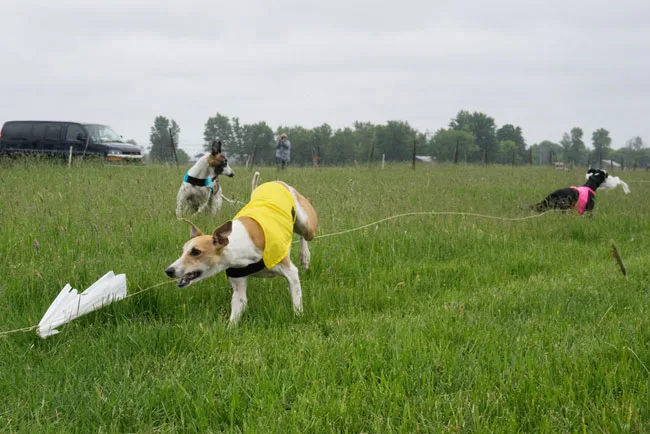
The lure operator lays out the course and is responsible for running the lure during the competition. They attempt to keep the lure 10 to 30 yards in front of the lead hound and they must be ready to stop the lure if a dog gets tangled in the line or another potentially dangerous situation develops.
Safety in lure coursing
In lure coursing, the safety of the dogs is always a priority.
This includes ensuring both the course design and the terrain are safe.
Prior to a competition, judges walk the field to check for any hazards. They can also adjust the course if needed. Miceli explains, “Say if the angle of this corner is not to their liking, they could request that it be changed. So that perhaps the dogs are not going to overshoot and get into an area where they shouldn’t be.”
Fenced vs. non-fenced
Miceli finds that dog owners are most concerned about proximity to traffic. Lure coursing events are held on large fields, some of which are not fenced.
Many people feel more comfortable running on a fenced field. However, sighthounds are very focused on the lure and usually follow it back to their handlers and are not distracted by other targets off-course.
Some dogs may experience minor foot injuries as a result of lure coursing. Depending on the conditions of the field, the pads on their feet may get worn. This can be managed by taping your dog’s feet. Toe injuries, caused by a hard turn, may occur. The usual solution to most lure coursing injuries is rest and recovery.
Miceli cautions, “Most sighthounds… love running so much and they love chasing so much, that a lot of dogs would run injured. It’s really our responsibility to make sure that never happens. That they’re always fit and healthy and not injured and having a good time.”
How to train a dog for lure coursing
For sighthounds, the desire to chase and run is a natural instinct. They either have it, or they don’t.
When puppies are very young, approximately 8-12 weeks old, a breeder will put a plastic bag on the end of a rope or a long pole and wave it and jiggle it around. If the puppies get playful and pounce on the “lure” they might have an interest in lure coursing.
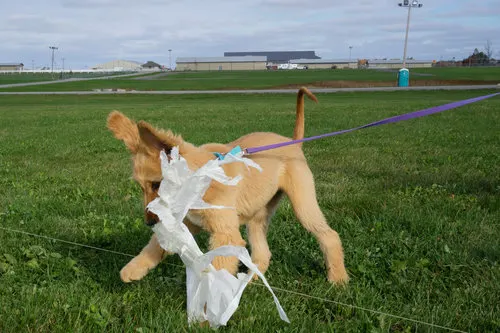
Miceli has experienced first-hand that breed and genetics do not guarantee lure coursing success. “My most recent group of dogs that I have are not interested in running. Their mother was one of the top borzoi in Canada for a couple of years and her brother was the top borzoi. So when none of this group ran that surprised the heck out of me.”
Keeping your dog fit
If your dog has the instinct to chase, your responsibility is to keep them fit. This means feeding them a healthy diet that is a good source of energy and then giving them opportunities to safely run freely.
The loin muscle, which runs from their ribs to their hip, gives sighthounds their rear drive and incredible speed. “It really is one of the most important muscles in their body,” says Miceli. “It has to be nice and strong and supple and have good flexibility. The big way to get that flexibility is with free running.”
Playing, chasing balls and running after other dogs are some of the ways to exercise the loin muscle. Miceli admits that having a pack of borzois is helpful in this instance. When she had just one dog and lived in the city several years ago, she took him to empty fenced baseball diamonds. “I’d go after hours and get him to chase me around. They just want to go because they love it so much.”
What is FastCAT?
FastCAT is another lure coursing event worth mentioning. FastCAT is an AKC event open to all purebred dogs and mixed-breed dogs. It stands for “Coursing Ability Test” and is a timed 100-yard dash where dogs run one at a time (vs. multiple dogs running together).
To participate, the dog must be at least 1 year old and have an AKC number as a recognized purebred dog or as an “AKC Canine Partner,” which is for mixed-breed dogs.
Check out this video of Olivia the hound running a FastCAT event. Olivia is a breed called the Grand Basset Griffon Vendeén (or GBGV).
Lure coursing near me
If you think your dog might be a good fit for lure coursing, the best way to know for sure is to attend an event.
Watching the event will show you how things work. And you can bring your dog and see how it reacts. “You’ll know if your dog is interested because they’ll get all excited,” says Miceli. “They’ll want to go. They’ll want to chase. It’s hard not to get swept up in their energy.”
Talk to officials and exhibitors—especially those with the same breed of dog as you. Most will be happy to tell answer all of your questions about the sport.
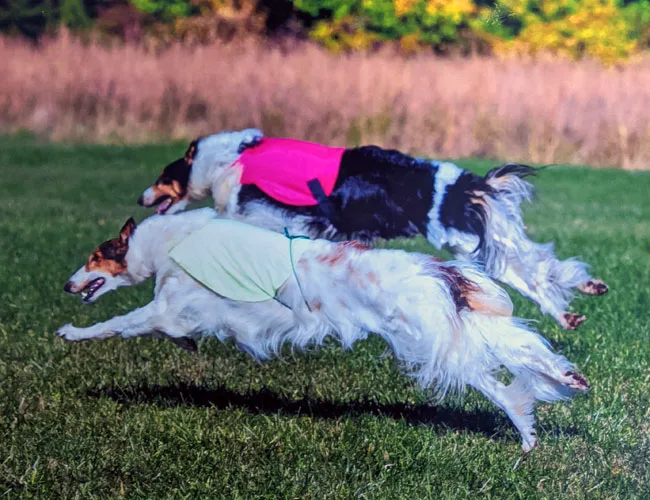
Then, if you decide you want to give lure-coursing a try, you can register for an event yourself.
Events are listed on the CKC website in Canada or in the US through the American Sighthound Field Association (ASFA) or the AKC. You can find FastCAT events on the AKC’s website. Your dog does not need to be a sighthound breed to participate in FastCAT.
Love for the sport
For Miceli, her love of lure coursing is rooted in her love of the borzoi breed. “Hundreds of years ago the borzoi were bred to hunt wolves in Russia and smaller game like hare. It’s been their instinct from their very beginning. They hunt by sight and they chase. And they do it for the fun and the love of it.”
“It’s the most spectacular scene to watch a borzoi in full flight. Fully extended and then all tucked up. It just takes my breath away.”
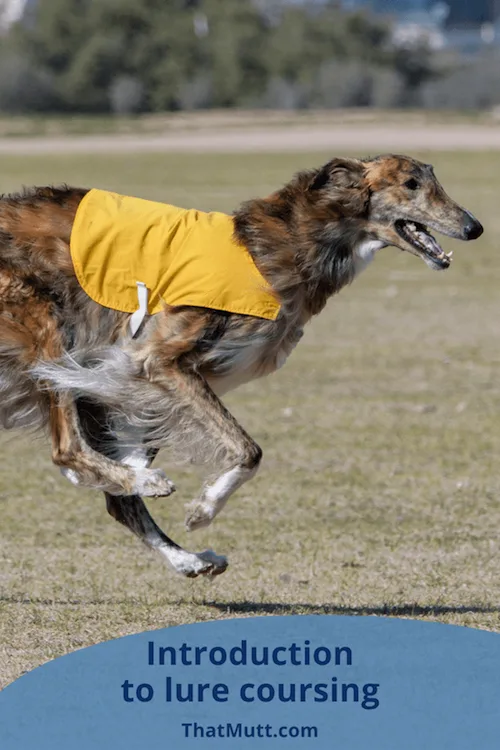
Julia Preston writes for That Mutt about dog behavior and training, working dogs and life on her farm in Ontario, Canada. She has a sweet, laid-back boxer mix named Baxter. She is also a blogger at Home on 129 Acres where she writes about her adventures of country living and DIY renovating.
Related articles:

Johnice Reid
Thursday 22nd of October 2020
Thank you so much. That gives me a good idea for the minimal space. I will Google the size of a soccer field and double it for the space I have in mind. I truly appreciate your help. :)
Julia P.
Thursday 22nd of October 2020
I got some additional info from Lisa. She says: "Most of the fields we run on are 10 to 20 acres. The minimum length of a course is 650 yards but we more commonly run about 850 up to a 1000 yards. We have run on fields of about 5 acres but that is certainly not preferred as it becomes a safety factor and we don't want dogs over shooting and potentially running into a fence."
Hope that this helps.
info sehat family
Wednesday 21st of October 2020
amazing, very good and helpful article for dog lovers. thanks Julia
Julia P.
Thursday 22nd of October 2020
I'm glad that you enjoyed it.
Johnice Reid
Tuesday 20th of October 2020
I love the sport and wish I could introduce it in my city. We have open spaces yet, I would like to know how much space is needed for a large event to be held. How many acres? The spot I am thinking of is the size of two soccer fields and I can negotiate use with the city.
Julia P.
Tuesday 20th of October 2020
I'm glad that you're so enthused. The CKC Rules and Regulations don't give a specific size for a field. They say "When using a continuous loop system, the angles should not be less than 45 degrees." and "A course shall not be less than 600 yards (549m) in length and the first pulley should be at least 50 yards (45.7m) from the starting line." So you need space to run a 600 yard course without making the angles and turns too sharp. I will see if I can get a better idea of size from Lisa, whom I interviewed for this article.